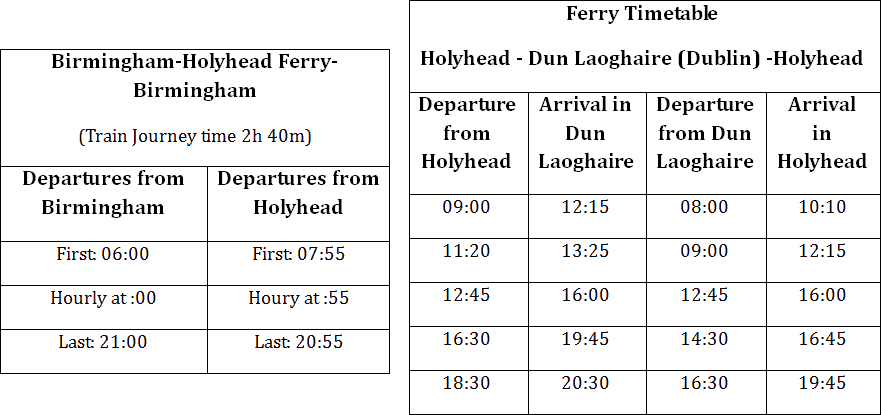
In this tips and tricks article, we describe a method that is very helpful in solving timetable-type questions in EPSO AST (EU assistant) organising and prioritising tests. Let's take a look at an example where you have to not just take a train but a ferry as well to get to a meeting, and you need to figure out how long you can tay if you want to make it back home the same day. To mix things up a bit, you also need to get a cab at the ferry port to get to the meeting.
The exact question goes like this:
You are in Birmingham and need to get to Dublin for a meeting using the means of transport shown in the tables. The taxi from Dun Laoghaire (pronounced Dun Leery) takes 30 mins. What is the maximum length of meeting you can attend if you need to return on the same day? (Assume shown journey times include transfer times to the next transport.)
Now let's look at the table provided.

Having read the question and the looked at the table, let's note a couple of interesting things:
- very important pieces of information are provided in the question text, e.g. the taxi ride duration and the fact that transfer times are included in the times shown in the table
- there are several factors to consider, e.g. which direction we are travelling in (both, in this case, but the chronology is important), which transport we need to take first, and so on
- we need to notice that the train journey time is given in one of the table headers
In a nutshell, there are a lot of factors to consider so it is important to adopt a systematic method when figuring out the answer to the question.
In tests like this, a strict chronological method is essential.
Let's see what the stream of consciousness while solving this test would be.
#1 We need to leave home as early as possible to maximise the time available for the meeting.
#2 That means taking the 06:00 train from Birmingham, which will get us to Holyhead Ferrry at 08:40.
#3 This will allow us to take the first ferry to Dun Laoghaire at 09:00, getting us to Dublin ferry port at 12:15.
#4 A 30-minute cab drive will get us to the meeting at 12.45.
So how long do we have for the meeting? We can stay as long as we can catch the last ferry at 16:30.
#5 Let's not forget about the 30-minute cab drive, so we need to leave the meeting at 16:00.
We could now calculate the rest of the journey home, but let's realise that this is not necessary - we only needed to know the time we have available for the meeting.
How much is that? From 12:45 until 16:00, it is exactly 3 hours 15 minutes.
Want to practice more questions like this?
Check our Practice Packages and select the EPSO